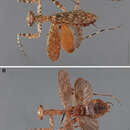Description
provided by Zookeys
Female. (Fig. 7A) N=1: Body length 29.75; forewing length 19.54; hindwing length 16.35; pronotum length 8.15; prozone length 2.46; pronotum width 3.68; pronotum narrow width 2.46; head width 6.90; head vertex to clypeus 2.88; frons width 2.78; frons height 1.10; prothoracic femur length 8.45; mesothoracic femur length 9.50; mesothoracic tibia length 7.50; mesothoracic tarsus length 6.48; metathoracic femur length 9.42; metathoracic tibia length 10.72; metathoracic tarsus length 9.13; pronotal elongation measure 0.30; pronotal shape measure 0.45; head shape measure 0.42; frons shape measure 0.41; anteroventral femoral spine count 14; anteroventral tibial spine count 10; posteroventral tibial spine count 7.
Head (Fig. 40G): As long as broad, the juxta-ocular protuberances very large, the apex in the middle; the vertex is slightly concave, above the dorsal margin of the eyes. Frontal suture with a very faint medial carina forming a continuous arc, may be seen primarily because of pale coloration compared to the dark markings above and below. The region ventral to the frontal suture depressed, gradually sloping higher to the central ocellus. Ocelli small and protruding on a carina that connects all three and extends laterally a short distance; the lateral ocelli oriented outward; area just ventral to central ocellus depressed (upper region of frons). The carina of the frons pronounced, the medial region just ventral to the carina depressed, sloped ventrally. Clypeus slightly transverse, the upper margin slightly convex, the lower margin concave; the central carina strongly pronounced and straight. Antennae is pale at the base, the flagellum absent from specimen. Curved, black band extending over the frontal suture, the carina pale; projections from the band extend dorsally from the middle, ventrally toward the central ocellus, and surrounding the lateral ocelli and extending laterally above the antennal insertion. Lower region of frons darkened; the clypeus is pale; the mandibles mostly pale, but with some brown marks distally; the labrum pale but with two laterally position black marks near the dorsal margin; the vertex and juxta-ocular protuberances mottled with pale and brown. Palpi are pale.
Pronotum (Fig. 47G): Short and squat with a moderately defined supra-coxal bulge; dorsal surface with a few blunt tubercles in the posterior half. Prozone squat with tapering margins anteriorly to a rounded margin; the margins smooth. Metazone with posteriorly tapering margins until the posterior half where the margins are parallel before widening again prior to the posterior margin; posterior two thirds of the margins with small tubercles; posterior margin with a slight medial emargination; the dorsal surface of the posterior half of the metazone depressed. Pale with strong black marks across the surface, two prominent black marks laterally just anterior to the supra-coxal sulcus.
Prothoracic Legs: Femur squat and robust with a slightly concave dorsal margin; strongly defined pale to dark banding on posterior (external) surface; anterior (internal) surface mostly pale, but with a faint dark mark medially and the distal third with a black band running along the medial line with an expanded region near the femoral brush; the ventral surface pale. Posterior surface of femur with few tubercles. A shallow femoral pit to accommodate terminal posteroventral tibial spine positioned medial to the two most proximal posteroventral spines and in line with the most distal discoidal spine; pit is pigmented brown. Posterior prothoracic femoral genicular spine much smaller than posteroventral spines, originating distal to the beginning of the genicular lobe. Prothoracic tibial posteroventral spines with the first (proximal) smallest and the fourth through sixth of similar length, the second and third are longer, but the second is very long. Prothoracic coxae smooth, the anterior surface pale.
Meso- and Metathoracic Legs: Femora with ventral (posterior) carina; dorsal (anterior) carina pronounced. Mesotarsi with first segment shorter than the remaining segments combined.
Wings: Forewings evenly mottled with brown and green, without large contrasting regions of pale marks; the costal region without strongly defined banding, green and brown mottling; veins green and contrasting from surrounding coloration; two pale spots are positioned in the proximal quarter of the discoidal region just posterior to the first radial vein. Forewings asymmetrically colored, one being mottled as described the other is darkened significantly with a rust tone, the mottled pattern still visible; extending slightly beyond the abdomen. Hindwings with discoidal region opaque and colored yellow or orange, darkening distally; the anal region with a very narrow anterior margin colored as in the discoidal region, hyaline otherwise; the terminus of the discoidal region projecting beyond the distal margin of anal region, the wing appearing slightly elongate, but still broad.
Abdomen: Broad, widening until the fifth tergite before a gradual posterior narrowing; a smooth, brown and black colored dorsal surface. Tergites without posterolateral tergal projections. Supra-anal plate slightly transverse, margins tapering gradually to a rounded terminus.
- bibliographic citation
- Svenson G (2014) Revision of the Neotropical bark mantis genus Liturgusa Saussure, 1869 (Insecta, Mantodea, Liturgusini) ZooKeys 390: 1–214
- author
- Gavin J. Svenson

